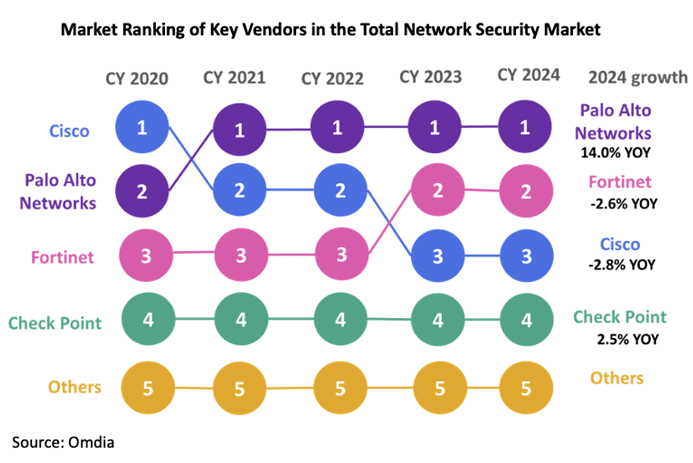The network security market experienced a year-on-year growth of 5.1% in Q4 2024 and a total growth of 3.1% for the full year, as reported by Omdia. The firm’s estimates and forecasts extend through to 2029, highlighting a robust landscape for cybersecurity solutions.
Palo Alto Networks emerged as the market leader in 2024, commanding a 28.4% share, driven by consistent demand for security appliances and a surge in the adoption of software and Secure Access Service Edge (SASE) components.
Omdia’s report delves into various segments of the network security market, including integrated security appliances, secure routers, SSL VPN gateways, and firewall software. According to Ketaki Borade, senior analyst at Omdia, “Palo Alto Networks, Fortinet, Cisco, and Check Point continue to lead the network security market, each holding double-digit shares consecutively for the last five years.” The growing adoption of SASE architecture is a key driver behind the acceleration of software integrations in the sector.

Rik Turner, senior principal analyst at Omdia, noted that the enduring dominance of the top four firewall vendors reflects a mature market. He stated, “If they strategically position themselves in the still early-stage SASE market, they have the potential to strengthen their grip on network security for years to come.”
Notably, Check Point and Cisco have shifted their focus away from developing internal cloud-native security products, opting instead to partner with Wiz, a move aimed at enhancing their competitive stance against Palo Alto.
Palo Alto has maintained its top position since 2021, largely due to its platformization strategy, which emphasises AI-driven product integration. Meanwhile, Cisco has climbed to third place, and Fortinet's targeted approach combining secure networking and unified SASE has propelled it to second place. With approximately 25% of its FortiGate devices due for refresh, Fortinet is poised for a potential revenue surge over the coming two years.
Looking ahead, Omdia anticipates strong growth for firewall vendors, particularly as refresh cycles emerge in the next two years. However, it’s worth noting that all four top vendors have issued cautious guidance for 2025, reflecting concerns over market growth. Factors such as enterprise cost-cutting and a shift towards cloud solutions may impact demand for traditional hardware firewalls, while software firewalls gain traction.
Overall, Omdia forecasts a compound annual growth rate (CAGR) of 2.8% for the total network security market from 2024 to 2029, with firewall growth projected at 5.0% CAGR during the same period. As the market evolves, increased product integration and SASE adoption will play crucial roles in shaping its future trajectory.



